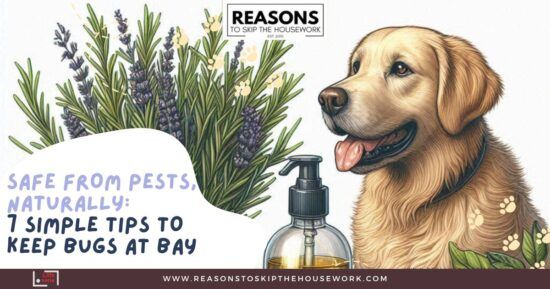
Safe from Pests, Naturally: 7 Simple Tips to Keep Bugs at Bay (Without Freaking Out Your Dog or Burning Your Eyebrows Off)
Let’s be honest—keeping your home and pets bug-free shouldn’t involve lab coats, warning labels, or a biohazard suit. If your idea of pest control leans more “natural” and less “chemical warfare,” you’re in the right place.
Turns out, Mother Nature has been stockpiling an arsenal of insect-fighting ingredients right in your pantry and garden. Garlic, citrus, herbs—who knew the key to bug-free bliss was practically hiding next to the olive oil?
So grab your spray bottles and prepare to battle bugs the crunchy, crafty way—with ingredients you can pronounce and your pets won’t freak out over.
1. The Power of Garlic: Nature’s Shield Against Pests
Garlic isn’t just for warding off vampires or leveling up your pasta sauce. Its sulfur compounds make it a natural enemy to ticks, fleas, and even mosquitoes. But hold up—don’t toss cloves into your dog’s kibble. Garlic can be toxic to pets in large amounts. Instead, go DIY with a diluted garlic spray or garlic oil for outdoor spaces. Bonus: planting garlic in your garden adds flair and keeps bugs at bay. Two birds, one bulb.
2. Neem Oil Extract: An Ancient Remedy for Modern Problems
Neem oil has been nature’s pest control MVP for centuries. Its strong scent is a big nope for bugs like fleas and ticks, while its soothing properties make it perfect if a few pests snuck in a nibble. Just remember to dilute it with water or a carrier oil before using it around your pets or furniture. Neem: it smells funky, works brilliantly.
3. Essential Oils That Keep Insects at Bay Safely
If bugs hate it and your home smells amazing—that’s a win-win. Essential oils like lavender, eucalyptus, and cedarwood are top-notch for keeping insects at arm’s length. They’re also great for giving your home spa vibes. But PSA: not all essential oils are pet-friendly. Tea tree oil, we’re looking at you. Always dilute, and stick to oils that keep your pets safe and your space bug-free.
4. Using Citrus to Naturally Repel Fleas and Ticks
Your lemons and oranges aren’t just breakfast garnishes—they’re flea-fighting superstars. The secret weapon? Limonene, a compound pests loathe. Boil some citrus peels in water, let it cool, and you’ve got yourself a fresh-smelling, flea-repelling potion. Spray it around the house or on pet bedding (not directly on pets!) and enjoy a bug-free, zesty zone.
5. Herbs from Your Garden That Double as Insect Deterrents
Herbs like rosemary, mint, and basil are like the cool multitaskers of the natural world. They spice up your meals and send bugs packing. Integrating herbs into your pet’s diet can support long-term health while contributing to natural pest resistance. For example, products designed to use a natural tick and flea repellent for dogs often incorporate rosemary or similar ingredients for added internal protection. Rosemary water also works wonders after baths by deterring fleas while leaving coats shiny and refreshed. Plant them in pots, dry them for sachets, or brew them into sprays. You can even add certain herbs to your pet’s diet (safely, of course) to boost their internal pest resistance. Rosemary rinse after bath time? Great for fleas and fabulous for fur. Plus, they pull double duty in DIY skincare balms—because you deserve soft, bug-free skin too.
6. Apple Cider Vinegar’s Role in Natural Pest Control Recipes
Apple cider vinegar is basically the overachiever of your pantry. Add a splash (with vet approval) to your pet’s water to make them less appetizing to fleas. Or mix diluted apple cider vinegar with water for a spray you can use on fur, furniture, and bedding. Bonus points: it doubles as a pH-balancing toner for humans. Bug repellent meets beauty routine? We love to see it.
7. DIY Recipes for Pet-Safe Bug Sprays Using Common Ingredients
Whipping up your own bug spray is as easy as mixing water, a dash of apple cider vinegar, and a few drops of pet-safe essential oils like lavender or cedarwood. A popular recipe includes water, a splash of apple cider vinegar, and a couple of drops of pet-safe essential oils like lavender or cedarwood. For an extra punch, toss in some neem oil or fresh rosemary tea. Spray it around the house, on pet beds, or gently mist it on your furry friend (avoiding their face, of course). It’s simple, customizable, and chemical-free.
Natural Solutions, Safer Choices
So there you have it—a natural, nose-friendly, and totally pet-approved way to keep bugs in their lane. Whether you’re garlic-spraying your garden or misting rosemary like it’s perfume, these DIY tips prove you can be pest-free without going full toxic-avenger. Your home, your pets, and your skin will thank you.
